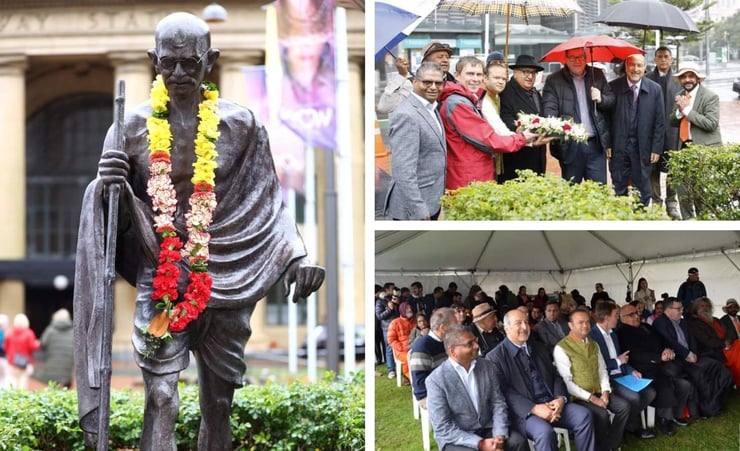Homage paid to Gandhi at iconic statue site in Wellington

Braving inclement weather, dignitaries and community members gathered under a tent to commemorate the 153rd birth anniversary of Mahatma Gandhi and paid tribute to the apostle of non-violence in the shadow of his statue in Wellington on October 2.
The statue, that was installed outside the Wellington Train Station in 2007, was garlanded and flowers were placed at its foot.
Welcoming the assembly, Indian High Commission Charge d’Affairs Mukesh Ghiya acknowledged the role of the Wellington City Council in co-hosting the event as well as the support extended by universities, Indian community associations and various charitable groups.
The United Nations acknowledged the relevance of Gandhi’s contribution by declaring October 2 as an International Day of Non-violence, Ghiya noted. He recalled Gandhi’s call for peaceful resistance against discrimination and injustice at a public meeting in Johannesburg in South Africa in 1906.
Satyagraha became a powerful tool of civil disobedience and non-violent resistance in India’s struggle for Independence. It had a profound impact on other political leaders such as Martin Luther King Jr and Nelson Mandela.
Ghiya referred to New Zealand Prime Minister Jacinda Ardern’s tribute to Gandhi at the recent UN General Assembly. “For me, there are three aspects of Gandhi’s message that carry particular weight: tolerance, equality and the sanctity of non-violence,” he quoted Ardern as saying.
In 2007, then Governor General Anand Satyanand joined Wellington Mayor Kerry Prendergast and Indian High Commissioner K.P. Ernest in unveiling the bronze statue of Gandhi, made by Indian sculptor Gautam Pal, which is now an adored landmark of Wellington, Ghiya added.
Ghiya concluded his address with a reference to the newly-appointed Indian High Commissioner to New Zealand, Ms Neeta Bhushan, who will be presenting her credentials on October 4.
Mayor Andy Foster invoked Gandhi’s belief that “non-violence is the greatest force at the disposal of mankind.”
“Mahatma Gandhi told us that ‘You must be the change that you wish to see in the world’,” Foster added.
Former Governor General Anand Satyanand highlighted the role of then Indian High Commissioner K. P. Ernest in installing the Gandhi statue in Wellington City in 2007. Anand, who originally hails from Fiji, noted the absence of a Gandhi statue in the Fijian capital of Suva, although Fiji had more people of Indian origin than did New Zealand. “[This] shows, I think, the special privilege that we have as New Zealanders in hosting the statue. I want to say, however, that Gandhi is revered in Fiji to a huge extent.”
Satyanand recounted how, in the early 1900s, an indentured labourer named Totaram Sanadhya secured his freedom, went back to India and wrote a cogent account of the treatment that indentured labourers were subjected to. This came to the attention of Gandhi, who dispatched Reverend C F Andrews to Fiji. Andrew’s report was instrumental in introducing legislation in 1920 that ended indenture permanently.
The former governor general hailed “Gandhi’s espousal of education”. Gandhi saw education as going beyond mere literacy. He viewed it as the “all round drawing out of the best in man, women and child, in body and spirit,” Satyanand said.
Deputy Prime Minister Grant Robertson reminded the audience that the cause of peace and justice remained constantly under threat. He said the war in Ukraine “challenges us all deeply to uphold the spirit of peace and justice for all who lived anywhere on our planet. The Mahatma said war is not a morally legitimate means of achieving anything permanent.”
Robertson said, quizzically, that “this week in New York, a quite remarkable thing occurred. And that was that the Mahatma spoke to the United Nations General Assembly.” It was done via a hologram, he explained. The hologram was developed in India using artificial intelligence (AI).
Robertson underlined the importance of incorporating Gandhi’s lessons of peace and non-violence in school education.
Dean of Diplomatic Corps Ahmad Salem Alwehaib described Gandhi as an icon of peace. “We must agree that peace was the foundation of all cultures,” Alwehaib said. He expressed his admiration for Prime Minister Ardern as a role model of peace and harmony in the aftermath of the Christchurch mosque attack. He closed with a quotation from the Quran: “We have made you into nations and tribes that you might know one another.”
Narendra Bhana, president of the NZ Indian Central Association, noted that Auckland was yet to succeed in installing a Gandhi statue similar to that in Wellington and requested Mayor Foster to put in a word with his counterpart in Auckland.
Mahamandaleshwar Paramhans Swami Maheshwananda from Yoga in Daily Life emphasised the oneness of humankind.
This was followed by a chanting of Gandhi’s favourite Gayathri Mantra, followed by a hymn, by Meena Ben Bhagwan Das from Gayathri Parivar.
Delivering the vote of thanks, Naginbhai Patel, founder and honorary chairman of the Pujaya Mahatma Gandhi Birthday Commemoration Committee of New Zealand, traced the history, and his role, in how Wellington got its Gandhi statue .
The dignitaries posed for a photoshoot in front of the statue before dispersing.





